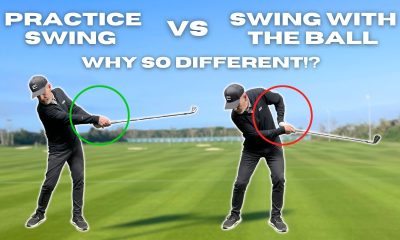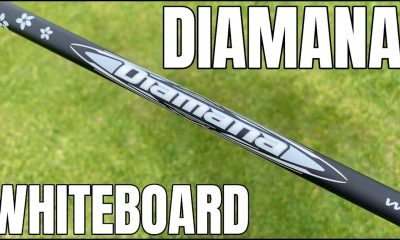Instruction
Clement: Laid-off or perfect fade? Across-the-line or perfect draw?

Some call the image on the left laid off, but if you are hitting a fade, this could be a perfect backswing for it! Same for across the line for a draw! Stop racking your brain with perceived mistakes and simply match backswing to shot shape!
- LIKE0
- LEGIT0
- WOW0
- LOL0
- IDHT0
- FLOP0
- OB0
- SHANK1
Instruction
The Wedge Guy: The easiest-to-learn golf basic

My golf learning began with this simple fact – if you don’t have a fundamentally sound hold on the golf club, it is practically impossible for your body to execute a fundamentally sound golf swing. I’m still a big believer that the golf swing is much easier to execute if you begin with the proper hold on the club.
As you might imagine, I come into contact with hundreds of golfers of all skill levels. And it is very rare to see a good player with a bad hold on the golf club. There are some exceptions, for sure, but they are very few and very far between, and they typically have beat so many balls with their poor grip that they’ve found a way to work around it.
The reality of biophysics is that the body moves only in certain ways – and the particulars of the way you hold the golf club can totally prevent a sound swing motion that allows the club to release properly through the impact zone. The wonderful thing is that anyone can learn how to put a fundamentally sound hold on the golf club, and you can practice it anywhere your hands are not otherwise engaged, like watching TV or just sitting and relaxing.
Whether you prefer an overlap, interlock or full-finger (not baseball!) grip on the club, the same fundamentals apply. Here are the major grip faults I see most often, in the order of the frequency:
Mis-aligned hands
By this I mean that the palms of the two hands are not parallel to each other. Too many golfers have a weak left hand and strong right, or vice versa. The easiest way to learn how to hold the club with your palms aligned properly is to grip a plain wooden ruler or yardstick. It forces the hands to align properly and shows you how that feels. If you grip and re-grip a yardstick several times, then grip a club, you’ll see that the learning curve is almost immediate.
The position of the grip in the upper/left hand
I also observe many golfers who have the butt of the grip too far into the heel pad of the upper hand (the left hand for right-handed players). It’s amazing how much easier it is to release the club through the ball if even 1/4-1/2″ of the butt is beyond the left heel pad. Try this yourself to see what I mean. Swing the club freely with just your left hand and notice the difference in its release from when you hold it at the end of the grip, versus gripping down even a half inch.
To help you really understand how this works, go to the range and hit shots with your five-iron gripped down a full inch to make the club the same length as your seven-iron. You will probably see an amazing shot shape difference, and likely not see as much distance loss as you would expect.
Too much lower (right) hand on the club
It seems like almost all golfers of 8-10 handicap or higher have the club too far into the palm of the lower hand, because that feels “good” if you are trying to control the path of the clubhead to the ball. But the golf swing is not an effort to hit at the ball – it is a swing of the club. The proper hold on the club has the grip underneath the pad at the base of the fingers. This will likely feel “weak” to you — like you cannot control the club like that. EXACTLY. You should not be trying to control the club with your lower/master hand.
Gripping too tightly
Nearly all golfers hold the club too tightly, which tenses up the forearms and prevents a proper release of the club through impact. In order for the club to move back and through properly, you must feel that the club is controlled by the last three fingers of the upper hand, and the middle two fingers of the lower hand. If you engage your thumbs and forefingers in “holding” the club, the result will almost always be a grip that is too tight. Try this for yourself. Hold the club in your upper hand only, and squeeze firmly with just the last three fingers, with the forefinger and thumb off the club entirely. You have good control, but your forearms are not tense. Then begin to squeeze down with your thumb and forefinger and observe the tensing of the entire forearm. This is the way we are made, so the key to preventing tenseness in the arms is to hold the club very lightly with the “pinchers” — the thumbs and forefingers.
So, those are what I believe are the four fundamentals of a good grip. Anyone can learn them in their home or office very quickly. There is no easier way to improve your ball striking consistency and add distance than giving more attention to the way you hold the golf club.
More from the Wedge Guy
- The Wedge Guy: Golf mastery begins with your wedge game
- The Wedge Guy: Why golf is 20 times harder than brain surgery
- The Wedge Guy: Musings on the golf ball rollback
- LIKE87
- LEGIT13
- WOW6
- LOL1
- IDHT0
- FLOP4
- OB1
- SHANK8
Instruction
Clement: Stop ripping off your swing with this drill!

Not the dreaded headcover under the armpit drill! As if your body is defective and can’t function by itself! Have you seen how incredible the human machine is with all the incredible feats of agility all kinds of athletes are accomplishing? You think your body is so defective (the good Lord is laughing his head off at you) that it needs a headcover tucked under the armpit so you can swing like T-Rex?
- LIKE0
- LEGIT2
- WOW2
- LOL0
- IDHT0
- FLOP0
- OB0
- SHANK2
-

 19th Hole2 weeks ago
19th Hole2 weeks agoDave Portnoy places monstrous outright bet for the 2024 Masters
-

 19th Hole4 days ago
19th Hole4 days agoJustin Thomas on the equipment choice of Scottie Scheffler that he thinks is ‘weird’
-

 19th Hole2 weeks ago
19th Hole2 weeks agoTiger Woods arrives at 2024 Masters equipped with a putter that may surprise you
-

 19th Hole4 days ago
19th Hole4 days ago‘Absolutely crazy’ – Major champ lays into Patrick Cantlay over his decision on final hole of RBC Heritage
-

 19th Hole2 weeks ago
19th Hole2 weeks agoTwo star names reportedly blanked Jon Rahm all week at the Masters
-

 19th Hole1 week ago
19th Hole1 week agoReport: LIV Golf identifies latest star name they hope to sign to breakaway tour
-

 19th Hole2 weeks ago
19th Hole2 weeks agoNeal Shipley presser ends in awkward fashion after reporter claims Tiger handed him note on 8th fairway
-

 19th Hole1 week ago
19th Hole1 week agoBrandel Chamblee has ‘no doubt’ who started the McIlroy/LIV rumor and why











gps
Nov 17, 2018 at 8:27 pm
The basis is the golfers pivot is around the right hip in BS and Left hip later in DS and in the follow through.
To imagine that we pivot on an imaginery spine stuck in the ground between our legs is ludicrous.
Ben Hogan set up with more closed stance with longer clubs and no one had hips as open to target line at impact. He was able to do that because of his lateral move during the BS, positioning his hips and right elbow ahead of the back of the ball in order to use his torso and arms to pull the golf club through the ball. The reason most cant open hips at impact is that they stay behind the ball and push the gold club, rather than pull. Muscles pull(contract) they dont push.
geohogan
Nov 17, 2018 at 2:01 pm
The basis of the pivot is that we pivot on the trail hip joint in the BS and pivot on the lead hip on the follow through.
It is a common fallacy that we pivot around our spine, as if the spine extend into the ground. LOL
Ben Hogan took a closed stance for the longer clubs and came to impact with hips more open than most. It had nothing to do with flexibility.
When he pivoted on right hip in BS, his right hip moved laterally toward the target during the BS, positioning the right hip ahead of the back of the ball and spine pointing behind his left heel(Farting behind lead heel*), for beginning of DS. From there it is simply a drop into the slot and a pure rotation into impact.
*Ref. The Hogan Manual of Human Performance: GOLF, 1992.
Richard Douglas
Nov 12, 2018 at 12:06 pm
This is solid, basic advice for a fundamental we often ignore.
The basis for the swing is a pivot around a single point: the spine. From there we can create the action with are arms, hands, feet, etc. That means we must rotate our hips (and, then, our shoulders) both back AND through the shot.
He mentions something that really should have merited more time, and that is we want the hips rotated towards the target before we strike the ball. In other words, by the time the club hits the ball, we’ve rotated 30-50 degrees (his measure). This allows the shot to “clear.” It also creates more lag in the swing an encourages a greater amount of shaft lean at impact–all good things.
Personally, I start the downswing with my left (forward) foot. Because I don’t lift the heel during the back swing, it’s a weight shift to that foot. The hips chase it, the shoulders chase the hips, the arms chase the shoulders, and the hands just ride the ride right through the shot. One move, lots of chain reaction, and one result.
One thing he did NOT mention about hip turn is its relationship with the width of your stance. The narrower your stance, the easier it is to generate hip turn. Professionals use a wide stance because they don’t have trouble rotating their hips. The wider stance encourages more stability and helps generate longer distances–if you can still rotate your hips. So if you struggle with the move described in the video, trying moving your back foot a bit more towards the front, narrowing your stance.
Another thing not mentioned is the impact of having an open or closed stance. A closed stance helps with turning back–which feels like a powerful move. But it restricts the hips from turning forward, causing you to be more square at impact–not good for the reasons described above. You end up trapping the ball to keep from coming over the top and pulling it. By opening your stance just a bit, you encourage your hips to open fast on the downswing. Too much and you’ll start fading the ball, so use this in moderation. In “Swing Like a Pro,” computer modeling showed that most professionals set up slightly open. You should try it.
Benny
Nov 12, 2018 at 12:41 pm
Loved your details more than the video. Thanks Richard Douglas!
gps
Nov 30, 2018 at 11:02 pm
to keep from coming over the top simply supinate the trail hand from the top of DS and dont stop.
OTT has nothing to do with foot placement , open or closed.
Its much easier and natural to slide under the inside of the ball from a closed stance.
Of course if your trying to hit the back of the ball, pull and pull hook are always in the equation.
gps
Nov 30, 2018 at 11:10 pm
A pivot is around an axis or fulcrum. The shoulders pivot around the spine.
The spine does not form a solid base into the ground so how could the golf swing pivot around an imaginary axis in space?
We pivot on the trail hip in BS and the other hip on follow through.
We could pivot around the spine if it extended into the ground BUT it doesnt.
Another misconception in the golf swing, that has been perpetuated for too long.